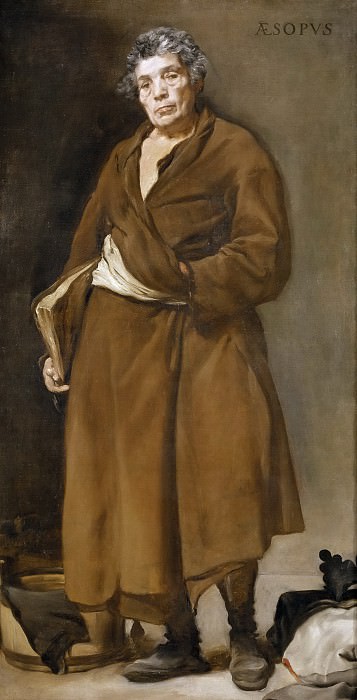Velázquez, Diego Rodríguez de Silva y – Esopo Part 3 Prado Museum
Part 3 Prado Museum – Velázquez, Diego Rodríguez de Silva y -- Esopo
Edit attribution
Download full size: 1490×2929 px (1,6 Mb)
Back to album: Part 3 Prado Museum
In the ancient Greek era, it was Aesop who was incredibly famous. The fables he created were told by people to each other. It was he who embodied all sorts of human types in the form of various animals. These are constant greed, incredible stupidity, great vanity and others. Many, listening to his fables of extraordinary poignancy, recognized themselves in them. Aesop was a slave. When his master became convinced of his intelligence, he let him go free. There are many curious legends about Aesop’s appearance.
Description of Diego Velázquez’s painting Aesop
In the ancient Greek era, it was Aesop who was incredibly famous. The fables he created were told by people to each other. It was he who embodied all sorts of human types in the form of various animals. These are constant greed, incredible stupidity, great vanity and others. Many, listening to his fables of extraordinary poignancy, recognized themselves in them.
Aesop was a slave. When his master became convinced of his intelligence, he let him go free.
There are many curious legends about Aesop’s appearance. He was usually portrayed as short in stature, necessarily hunched over, and absolutely repulsive. But in fact, many writers deliberately worked to create such an appearance of Aesop, deliberately enhancing all those features that were unpleasant. This was done to highlight the inner beauty of the man against the background of his ugly appearance.
Velázquez portrays the legendary fable writer Aesop. His face is slightly puffy and his clothes are completely shabby. We see a vagabond who used to be a slave. But everything changes when we pay attention to Aesop’s gaze. He looks like a judge who is mercifully listening to excuses, or a doctor scrutinizing a patient, or perhaps a teacher who is about to reprimand a student. Perhaps it is God himself who is watching over a humanity that is constantly gagging. The man who had been at the bottom of society had become almost on top of God himself.
It was incredibly important for Velázquez to show a special wisdom that is divorced from social status and his dignity. Such people are utterly devoid of any gloss. They are far outside society. But it is precisely for them that maximum understanding of all of that society is necessary.
On the one hand, the philosophers of Velázquez are utterly deprived of life, but for this reason their knowledge of life is incredibly profound.
Кому понравилось
Пожалуйста, подождите
На эту операцию может потребоваться несколько секунд.
Информация появится в новом окне,
если открытие новых окон не запрещено в настройках вашего браузера.
You need to login
Для работы с коллекциями – пожалуйста, войдите в аккаунт (open in new window).




















You cannot comment Why?
The man’s attire contributes significantly to his characterization. He is clad in a voluminous, earth-toned cloak or robe that obscures much of his body. The fabric appears worn and somewhat soiled, suggesting a life lived outdoors or amongst hardship. Beneath the cloak, a glimpse of a white cloth can be seen, possibly a tunic or undergarment. His footwear consists of simple, dark leather boots, scuffed and bearing signs of use.
At his feet lies a pile of what appears to be discarded clothing or bedding – further reinforcing an impression of poverty or itinerant existence. A book is held in the man’s left hand, partially obscured by the folds of his cloak; this detail suggests a connection to storytelling or wisdom. Above his head, inscribed in capital letters, is a name: AESOPS.
The artists handling of light and shadow is notable. The figure emerges from the darkness with a dramatic chiaroscuro effect, highlighting the texture of his skin and clothing while leaving much of the background shrouded in obscurity. This technique draws attention to the subject’s face and hands, emphasizing their expressive qualities.
Subtleties within the painting suggest layers of meaning beyond a simple portrait. The mans gaze is not directly engaging; it seems to look past the viewer, as if lost in thought or recalling memories. His posture conveys a sense of resignation rather than defiance. The inclusion of the name AESOPS implies an association with the ancient Greek fabulist known for his moral tales and satirical observations on human nature. This connection suggests that the depicted man embodies qualities of wisdom, experience, and perhaps even a degree of cynicism gained through observing the worlds follies. The overall effect is one of quiet dignity tinged with melancholy, inviting contemplation about the passage of time, the burdens of knowledge, and the complexities of human existence.